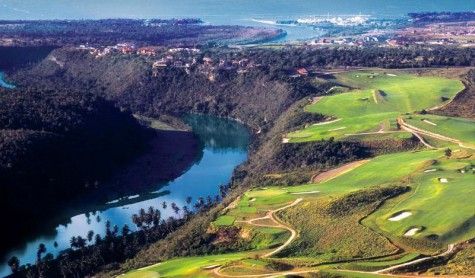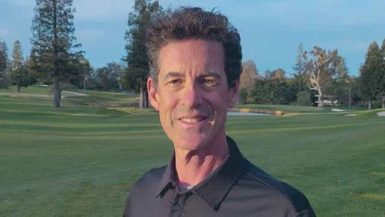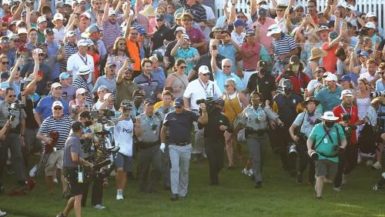
[Author’s Note: We’ll be at Casa de Campo for the reboot of the GolFantasy vacations franchise. In prep, here’s Pete Dye breaking down the courses like a fraction for us, along with some observations about modern equipment Alice makes a cameo appearance as well, stealing every scene she enters!]
Jay Flemma: Tell us a little about building Teeth of the Dog.
PD: It’s got seven holes right on the ocean, in fact right in it! And I like it as much as anything I’ve ever done.
JF: Why?
PD: You don’t get seven holes by the ocean very often!
(Laughter)
JF: Why else?
PD: Everybody asks me what my favorite course is, and I don’t know, but I will say that when I started down there, there wasn’t anything within 35 miles. Now 40,000 people have jobs, there’s 3,000 homes, five courses, a marina, an airport, new roads: it’s really grown down there. And now they have the new interstate, and it goes right by us and then it goes north and east, so it’s viable. You can get around easily.
And they have so much land there, they have 550,000 acres total, so the resort is on the 7,000 acres that was dry and not being used by cattle and goats, and the Chavon River irrigates the whole place. And, of course, Teeth has had such great play for so many years; they’re doin’ okay down there!
JF: Tom Doak wrote that he thought Teeth was your favorite course. Is he right?
PD: Well like I said we put 40,000 people to work!
JF: Anything about the design make it your favorite?
PD: You have seven holes on the ocean!
(Laughter)
And I put four holes on the water for one nine and three on the other, and I made sure to have the water half the time on the left and half on the right and on both the par-4s and the par-3s, so there’s variety and it’s in equal amounts.
JF: It’s balanced?
PD: Yes. Plus, it’s a much better golf course today than when I opened it.
JF: I hear you had rather primitive materials to work with, so it was especially tough to build Teeth of the Dog in the first place.
PD: When I first started there we had a lot of laborers, bulldozers, and small carts. They were one of the largest sugar operations in the world there.
They had bulldozers, but not with blades on them. They just used them to plow the fields. So I put a blade on one of the D-5s or D-6s, and I taught Moquita – one of the local workers down there – how to use the blades to move the earth around, and he’s been really great. He worked the dozers plowing the fields, so he caught on real fast to the earthmoving for the golf course. He’s become really proficient, and now with all the expansions, they use him all the time for the grading. He’s really good at that.
Other than that we really just had man power, 200 people, and the sugar cane carts. We had coral rock and we chopped the sharp points off and covered it with dirt that came from the sugar cane fields. We did everything by hand.
JF: Was it the hardest site you ever had to build on?
PD: Not if we had machinery!
(Laughter)
JF: How much earth did you move and how many acres is the golf course?
PD: It was all topsoil, about 1,500 yards per acre over about 100 acres, so somewhere between 150,000-200,000. Teeth is on about 150 acres of land overall. We didn’t change the contour of the ground – there were little rolls here and there – but it’s all hard coral rock, and if you try to push rock around, you’re crazy!
JF: And blowing it up costs money…
PD: Right! A lot of money! So we put topsoil on top of the coral rock. There’s only 2-3 feet of dirt on top of the coral, but holes 5-8 are right on the ocean and then 15-17 are right on ocean, so you don’t need much contour when you have the Gulf right up against the holes!
The greens are paspalum and now they can run 9-10 on the Stimpmeter.
JF: The holes look really wide!
PD: It is a resort golf course, you know…
(Laughter)
A guy and his wife have gotta be able to come here, and knock it around, and have fun, so…
JF: What are some of the best holes at Teeth?
PD: Well there’s three par-3s right in the ocean. The Caribbean is calm, with small waves so you can put the green right next to the ocean. I think they are fairly dramatic. The fifth is shorter than the seventh – five is 150 yards, but 7 is 190 yards – and I think 16 is 200. They vary in length, and they look different from each other.
JF: Tell us about that second hole with its diagonal hazard. Is that an arroyo or a dry wash?
PD: Water comes running right down the edge of that and dumps behind the eighth green, so it’s an arroyo, a wash for that purpose. But if you hook it off the tee you’re right in it. It also made for a good strategic hazard.
JF: Those bunkers cut into the green, the little pot bunkers…are those from 10 at Pine Valley?
PD: No, no. When Alice and I went to Scotland in ’63 we saw such a variety of bunkers. Now with all respect to Trent Jones and Seth Raynor, who’s one of my favorites if not my favorite, they all had a style, and that’s fine. So every hole on that course would be the same style bunkers. But that’s not what I saw in England and Scotland and Ireland. While every course had its own individual style and character, each course also had a lot more variety in the style bunkers. They’d have waste bunkers here, pot bunkers there, strip bunkers here, big bunkers, little bunkers, so that’s what I try to do too. But I try to put the most severe bunkers where the better golfer would hit the ball!
(Laughter)
JF: What other holes stand out at Teeth?
PD: Well, let’s see. The 15th and 17th are great, and on the front the sixth and the eighth. Six and eight have the water on the left, so you want to play right to left shots on those holes, but on the back the water is on the other side, so on 15 and 17 you want a left to right ball flight. Six is only 330 for members…
JF: So they can try to drive it close up to the green…
PD: Or even on it. The other thing about Casa de Campo is the wind. In December it starts to switch from southeast to northeast. It’s pretty calm, about eight knots, so there’s not much to worry about.
JF: So you don’t get the swirling effect at Whistling Straits or the crosswinds of Kiawah?
PD: No nothing like that. But the 8th green got whacked around by the Hurricane pretty good.
JF: Which Hurricane?
PD: Oh, all of them! We lose a little every time, but we always put it back. We put it back so fast it would make your head spin.
(Laughter)
JF: Are the inland holes at Teeth as strong as the inland holes at other cliff top courses like Pebble Beach? Or Bandon Dunes?
PD: I don’t think they’re as hard, but they play good anyway. I think the first few play fine, then you get to the Gulf. Then 10-13 play okay. But the course is a playable course. People play it all the time as it’s a resort course. Yeah, Fred Couples could reach the par-5s in two, but that’s Fred Couples. But it’s still playable by guys that shoot 95 or 99. And they keep the rough cut down, so if you knock it in the Gulf you lose your ball, but you’ll have a hard time losing balls anywhere else. The Ocean Course at Kiawah is more severe than teeth.
JF: How is Dye Fore different from Teeth?
PD: Teeth has seven holes on the ocean. Dye Fore has a big river, the Chavon. It’s 70 meters deep and the course is along the edge of the river bank. You have the mountains to the north, and the ocean to the south. It’s entirely and dramatically different. You don’t even think you’re in the same country. There’s also 30 meters of elevation change from the north part of the course to the south, and there are big ravines that come in and drop off 90 feet.
Because it’s up – and by that I mean elevated, not at sea level – you get the southeast and northeast winds, they are much more predominant than at Teeth or at Links. Also, the greens are bigger and have a little more contour. We had more land to play with as well.
JF: How many acres?
PD: Not sure, but I’d say around 250.
JF: What are the best holes at Dye Fore?
PD: The holes right on the ravine. On the front, three through six wind around the ravine and let you see everything. The drop-offs are around sixty or seventy meters, (225 feet), and the river is big. You can see huge expanses of it. Then on the north side 10-12 and fourteen and 15 are right on the bluff of the river, and you can see for miles. So the ambience is pretty dog-gone great! There’s a huge amount of land so the homes are set way back. People from all over the world build there.
JF: What about the Lakes? The new nine you just finished? [Author’s Note: From time to time Pete and I may refer to the Lakes as “Five” – Pete’s working title for the course and the one he still uses to this day when referring to the Lakes.]
PD: I like it very much. Like Teeth, it’s also on coral rock. You see, the Dominican Republic is the last (southernmost) uprising of the Rocky Mountain chain. The mountains in the middle of the island go up 11,000 feet! That’s higher than the U.S. That’s higher than Denver!
JF: Did that affect building the course at all?
PD: Well they had granite rock to work through. But the sugar mill had good equipment – 8-10 big bulldozers to plow 300,000 acres! – so all we had to do was put blades on!
JF: You called Five your best since Teeth. Why?
PD: It’s on coral. And I did some things at Five that I never did before anywhere else. I built some different green surrounds so that they really drop off!
Alice: I never saw him build a green with a 20-30 foot drop off. You have to chip back up the hill and the green is narrow…
PD: I think it’s a pretty good course and here’s why:
The game has changed dramatically from the good player’s point of view – so drastically in the last few years you can barely recognize the game. Jack Nicklaus hit it 265 and now they hit it 310 – that’s forty five yards. Nicklaus hit a 7-iron 150 yards, now its 190. So there’s 40 more yards. And don’t tell me the kids out there are stronger than Nicklaus and Palmer because they aren’t. Jack and Arnie were as strong as the kids out there now. But now the U.S.G.A. has let them hit it 40-60 sixty yards further per hole. Now if your course isn’t 8,000 yards its not gonna be competitive. They carry it 305-310!
So when you build a new golf course, you know kids will hit it a mile. So I want those guys at the back tees to have to work the ball. I did that at Five, but I still made it playable for 18 handicappers too.
The whole game has changed…I can’t say it’s for the better, but it’s better for ordinary golfers who want to drive it 300 yards, but cant putt or chip or score.
But you have to build a course so people play it and wanna come back. You can’t have it too long like the pros want it. The other day I went to Doak’s course in Oregon, and they had four par-3s in nine holes. I never saw that before, and I think that’s great!
JF: That stretch is great.
PD: Well he’s out there in the sand dunes, and it’s natural. But show anything unusual to pros and they scream. You have to walk on cotton when the pros come around, because they’re gonna yell! It’s a different world what Rory McIlroy and those guys hit it – they hit it so much differently than ordinary people that play golf. But I think Five can challenge the young kids just fine, but is playable by the resort guests.
JF: How much harder than Teeth is Dye Fore or Five?
PD: Not at all, they’re pretty much the same. Dye Fore maybe harder for the higher handicapper, but not the lower handicapper – it’s tougher on the higher handicapper because it’s a little more up and down on shots. There’s more vertical elevation change to the terrain.
JF: Where can we see Alice’s influence at Teeth, Dye Fore, or Five?
Alice: I did all the forward tees for women at the courses. And I consulted on some of the design. I walked it and we’d talk about it. On some of those holes, like ten at Teeth of the Dog, I did them because Pete was sick for few days with a cold.
JF: Why is Casa de Campo Number 1 in the Caribbean year in and year out?
PD: It’s different from anywhere else. They run it well and it grew. It’s huge. They have 550,000 acres for the sugar mill, 7,000 acres for the resort, and they employ 40,000. They’ve had forty years of great business, and with a world-wide clientele: Italians, Americans, German French. It’s a city all its own. It’s unbelievable what they’ve done there. They reproduced an Australian village, so they have really grown. And it’s beautiful. I don’t think I’ve seen anything like it in the world. First there was one course, then two, then a private course. I said they were crazy, but they filled it up before I finished. Now they have five courses, three public.
JF: People always show pictures of Teeth’s par-3s, and indeed, we see to talk most often about your par-3s. Do you think you are most famous for your par-3s?
PD: Well, let me tell you something how we design par-3s. [My wife] Alice played with Byron [Nelson] and Patty Berg and Sam Snead. Then she goes out and plays with Mary Jones and girls that can’t break 120. There’s nobody from Jack Nicklaus on down that has played with as many different people as Alice. She plays with everyone.
Now when we build a course, she asks “How does Mary Smith play this hole?”
JF: You mean Mary Jones?
PD: Either one. Or both.
(Laughter)
Now the average woman hits the ball straighter than the average man, so when you build a par-3 they have to have a shot at the green. For the men’s tee, you work back to it and make it as severe as possible, but you keep it so the ladies can play it. The par-3s are pretty stiff down at Casa but the ladies can play them.
Then on the par-4s there are some that are hard, I know, but I don’t put anything in front of the green so a lady can still play the hole. What I know is I have eight majors coming to my golf courses, but people still come and play them for vacation like Whistling and Kiawah.
JF: Of your own designs, what are some of your favorite par-5s? Private and public…
PD: Par-5s – I never really gave it a thought. 11 at Teeth and 3 Teeth are long for a good player, they go at it in two, (with a long iron or fairway wood), but I don’t mind that because the green is built for a wedge. Also 11 at the Ocean Course at Kiawah there’s another tiny green and they have a wood or long iron in their hands into a tiny green. I don’t want them hitting 6-iron into a par-5 green, I want them with a little longer shot. Long iron or fairway wood is what I want, but if they can get there, who cares? There’s enough defense around the green to make it dangerous. But you want to make them go for it. That’s the goal, make it reachable enough that they’ll take a run at it, but with enough trouble to give ’em headaches if they miss.
JF: Where do you think you are misunderstood the most as an architect?
PD: I really don’t care if people understand what it is or not that I’m doing; I just try to design the best golf holes. Sure I’m disappointed if the pros don’t like a tournament course I built, like say PGA West Stadium Course. But I don’t think I’m really misunderstood. I think they understand pretty well that a Tour course has to be hard on Tour pros. But PGA West Stadium course was first played by the pros in forty degree weather, they were playing in a pro-am with amateurs, and it took six hours to get around. Under those conditions, they wouldn’t have liked it if it was the best course in the world.
JF: What course was the most satisfying course of all those you’ve built?
PD: Either Whistling or the TPC Stadium Course or the Ocean Course. They are all long except the TPC in Jacksonville, and that still holds up. I don’t know what’ll happen in 10-15 years with the equipment – the USGA may just let everybody drive the par-4s. That’s crazy! It’s not the way the game is played. You’ve got guys hitting 6 and 7-irons into par-5s, and that’s nuts, but then they let you take a long putter and stabilize it to your chest. You’ve gotta be kidding me! That’s not a golf swing. By not passing rules that forbid such equipment, you change the game too much.
But when you build a golf course, if you can do it so it withstands change, then you’ve done your job. Look at the U.S. Open next year at Merion: they had to build a new tee box on one hole so far back that now you shoot over out of bounds and then back in bounds to get the length they need. I haven’t seen that very often…
JF: Do you feel that your success in designing hard courses has typecast you somewhat as a designer?
PD: No question. A lot of people don’t like it. I get complaints about holes and courses I’ve built, but then I get a place like Colleton and Long Cove, and they’ve done very well. And then the resorts like Teeth and the rest of Casa, and Sawgrass and Kiawah have done fine. And then I really like French Lick. It’s built on the highest point in Indiana, and we took trees down so any wind out of Kansas City is gonna hit you!
JF: How do you feel your architectural principles have been beneficial to golf and to golf architecture?
PD: Drainage. I was the first in the U.S. to put sump pumps in and drain like they do near basins. There are so few places with 50 feet of sand to build a course on: Northern Michigan and Vermont, and Long Island and Pinehurst. That’s great for them, but I built in Pennsylvania, West Virginia, Ohio, Indiana…even in California and I didn’t get sand. I never got sand like you find in England, Scotland, and Ireland. Even their inland courses are on sand! But we don’t have that natural drainage.
But when I went to Old Marsh and the Medalist, which I built for Norman, and at the PGA course I built…
JF: You mean the one in Port St. Lucie? The public one at PGA Village?
PD: Yes. I like that one a lot.
JF: I like that one a lot too.
PD: That’s a fun course. But there and everywhere else I mentioned, I moved a lot of dirt and was able to drain it. The reason is like in your basement you have sump pump and it gets out the water. So we did the same thing for our golf courses. So when it rains real hard, you don’t have to put a sign up saying “We’re closed.” At Old Marsh when it rains, it opens up before the all the rest of the courses, it’s at sea level! And then I built Sawgrass at below sea level and that drains well too. And we raised that finishing stretch of 16-18 out of the water.
JF: Tell us about La Romana, the private course down at Casa.
PD: It’s an excellent golf course. The greens are all open in the front, and it’s very playable. It’s not easy, but it’s not hard.
JF: Is it remotely similar to anything you;ve done anywhere else?
PD: Not really. I don’t use plans or drawings,, so I never copy any hole I’ve ever done before. That way I don’t get repetitive. You can see that in my bunkering. By having so many different styles of bunkers, even on the same hole, every hole can look and play uniquely
JF: What do you think about what Rory did to Kiawah?
PD: I loved it.
Alice: He anticipated it. He hit the score right in the nose, he picked sixteen under.
JF: What??!! How’d he do that?
PD: Well, you’ve got four par-5s, but with the equipment, there is no such thing as a par-5 anymore. So when they tee off, each day they start 4-under par! Add that over four days equals 16-under.
Alice: He did it. He told everybody that’s what the score would be and he got it. Remember, the definition of par is in the U.S.G.A. rulebook. It defines par as how many strokes it takes to get to the green plus two putts. So basically Rory even par, realistically.
JF: Which is tougher, Kiawah or Whistling Straits?
PD: Kiawah has to have some wind; it’s built to have wind factor into play. Other than that, they’re equal.
JF: What elements of Seth Raynor and company will we find at any of the courses at Casa?
PD: Seth built bathtub bunkers, and Ally wont let me build bathtub bunkers any more.
JF: How come?
Alice: Because it’s too hard to get down in them and then out of them again. People get stuck in them.





[…] A Walk In The Park […]
[…] A Walk In The Park – 328 Courses, 39 States, One Man […]